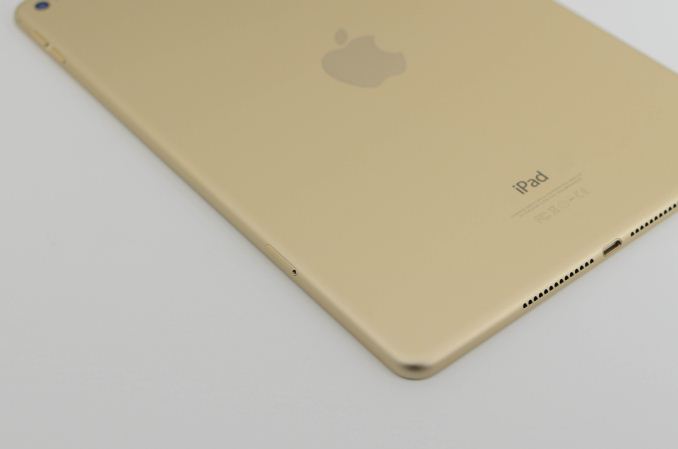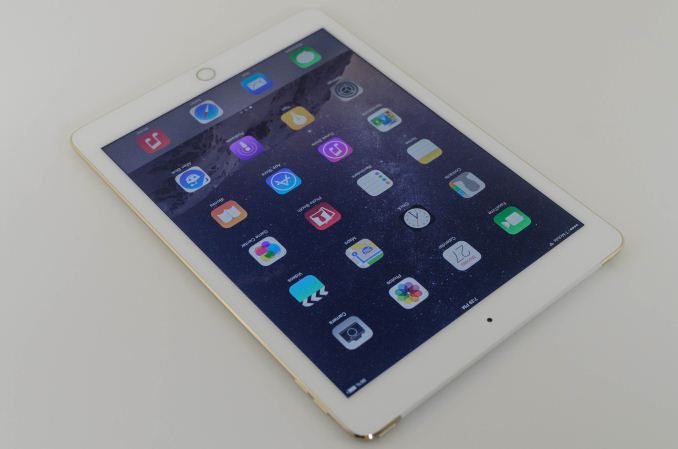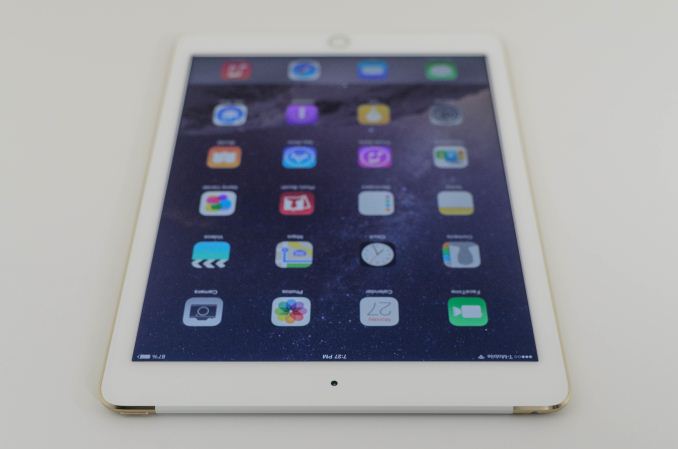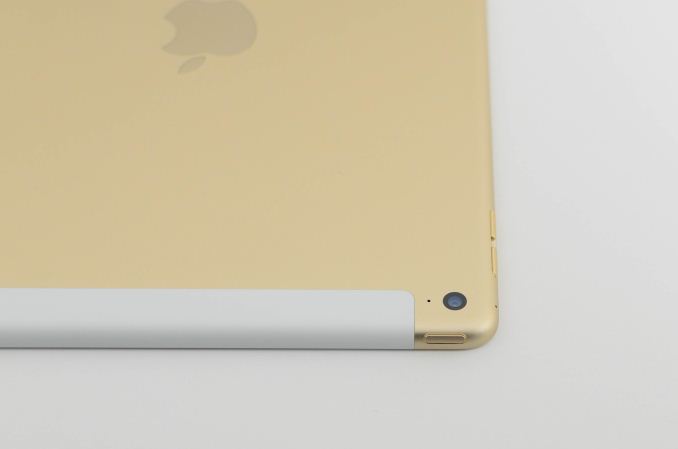The Apple iPad Air 2 Review
by Joshua Ho on November 7, 2014 9:30 AM EST- Posted in
- Tablets
- Apple
- Mobile
- iOS
- ipad Air 2
Final Words
Overall, there’s a lot to go over on the iPad Air 2. While the name suggests that it’s an iterative update in nature, in practice these updates add a lot of compelling hardware to the high-end iPad line. One of the first areas worth looking at here is the design. While not a radical shift from the iPad Air, the differences in design and the even thinner build helps to set the iPad Air 2 apart.
The next item of note is the A8X, which represents a return to dedicated SoCs for the iPad line. This is presumably done to preserve performance parity at native resolution for the iPhone and iPad line, and the extra CPU core is intriguing as it represents a shift away from the two CPU core system that Apple has stuck with for a while. In practice, this makes the iPad Air 2 one of the fastest ARM-based tablets on the market. Only NVIDIA’s Tegra K1 is able to compete with its GPU performance, and at the cost of greater heat and power consumption.
The next major point of note is the display. While not much has changed to the display itself, the surrounding components have seen a few upgrades that have been sorely needed for the past few years. The display is now laminated to the cover lens, which dramatically improves interactions with the device as the display feels much closer to the glass than before. The iPad Air 2 also has a custom anti-reflective coating on the display is really unlike anything else I’ve seen before as the frequencies reflected make the glass appear to be producing purple reflections. Despite keeping the tablet at 200 nits, I found that it was still fully possible to read the display outdoors during the day. There also seems to be some level of improved calibration, although the panel is mostly the same when judged by the appearance of the gamut and also the brightness/contrast numbers. At any rate, this display is more than capable of doing proper photo editing as the device is more than accurate enough for serious work.
Despite these upgrades and the smaller battery, in practice it seems that Apple has made good on their promise of generally unchanged battery life from the iPad Air. While there are phones and phablets out there with better battery life, I suspect that most will be more than happy with the battery life of the iPad Air 2. If one found battery life to be sufficient on a previous iPad, battery life on the iPad Air 2 should just be more of the same rather than any surprises. Apple also deserves some level of recognition for the incredible efficiency and sustained performance during this test as even the Tegra K1 can't quite do both.
There’s also the question of software, which continues to be class-leading on the iPad. While tablet applications that haven’t been properly scaled on the iPhone line are likely to look horrible due to the scaling factor used, this kind of experience is unlikely to occur due to the strength of the ecosystem at this point. While the same can and does happen with Android apps, it isn’t nearly as obvious because most of the scaling done is far more seamless and simply leaves a great deal of white space in the application that can’t necessarily be used.
As a result of all this work, it seems pretty obvious that the iPad Air 2 continues to deliver some of the best tablet software on the market. For the most part, every application available seems to effectively deliver a tablet-specific experience that helps to set the iPad lineup apart from other tablets. Unfortunately, it seems that due to a lack of competition there isn’t much in the way of attempts to dramatically improve the software experience, and as a result it’s a bit difficult for me to justify carrying a tablet around all the time as its size means I can't just put it in a pocket unlike a six-inch phablet.
However, there are still some notable new features, namely TouchID, which works incredibly well and leverages Apple’s tightly-meshed ecosystem to deliver a better experience than just about anything else on the market. Unfortunately, I’m not necessarily sold on TouchID on a tablet as an ergonomic ideal as the sheer width of the device makes it a bit harder than usual to properly place my finger for scanning. The functionality makes up for it though and TouchID remains one of the real killer features of Apple devices.
Finally, the camera is a nice step up from the iPad Air. While it may seem like an incremental step, a meaningful camera change to the iPad Air 2 is relatively surprising given that it hasn’t significantly changed since the iPad 3. It’s surprisingly competent in daytime, although at night a great deal more noise creeps in than one might expect from an iPhone 6 or similar device which has a larger sensor.
Overall, the iPad Air 2 is likely to be one of the only tablets worth buying on the market today. While iOS isn’t perfect, it’s definitely delivering the best tablet experience as its app support is second to none. While other OEMs may have more features, iOS manages to hold on by virtue of its superior polish and integration with Apple hardware. While I’d like to see Apple push the envelope further with the iPad line, it’s hard to argue this when other OEMs seem to be content with the status quo. While it’s likely that Apple will be able to hold on to its tablet lead, it remains to be seen if Google’s Nexus 9 can prove to be a viable competitor to the iPad Air 2.














226 Comments
View All Comments
nicolapeluchetti - Sunday, November 9, 2014 - link
I have a Kontrol S2 to play sound obviously :Dakdj - Thursday, November 27, 2014 - link
Yes and plenty more options coming as they've released for 2015 the protocolThe camera connect kit is a Lightining to USB standard 6" $20 peripheral. Good to go
akdj - Monday, November 10, 2014 - link
Plenty of options exist both with 30pin-out and lightning to send digital audio to an external DAC. Most systems are employing other storage methods (lossless, FLAC, WAV, et al) including thumb drives, externals and wireless transfers.It's changed (DJ'ing) a tremendous amount in a ¼ decade ;)
It's crazy to me, even with USB2, zero latency mixing digital music with an external DAC talking to an analog board with an analog output ...all in 'real time' and literally ZERO latency
It's awesome
darwinosx - Friday, November 7, 2014 - link
Hah, good luck with that. Seriously. You'll need it.sprockkets - Saturday, November 8, 2014 - link
Seriously, go fuck yourself appletard.KoolAidMan1 - Tuesday, November 11, 2014 - link
Look who's madFlunk - Friday, November 7, 2014 - link
That's because you're a technical person. Android aims these things at people who want the simplest interface, less options and a holistic management approach. Android is much more flexible and that's why almost all technical people prefer Android.I've got a Nexus 10 and a Nexus 5.
Mayuyu - Friday, November 7, 2014 - link
After I problem solve all day at work, I just want to unwind and use my tablet without messing with it.Midwayman - Friday, November 7, 2014 - link
I'm with you here. I really like the flexibility of android, but I get tired of always having to do something to make it work. I feel like any android device I get is about 90% finished and Its up to me to hit XDA and do the rest of the work.blacks329 - Saturday, November 8, 2014 - link
Both of these statements sound very reminiscent of my own sentiments I had towards Windows back in the day.Android is fantastically flexible, but at the end of the day, I don't want to think about dealing with it after work.